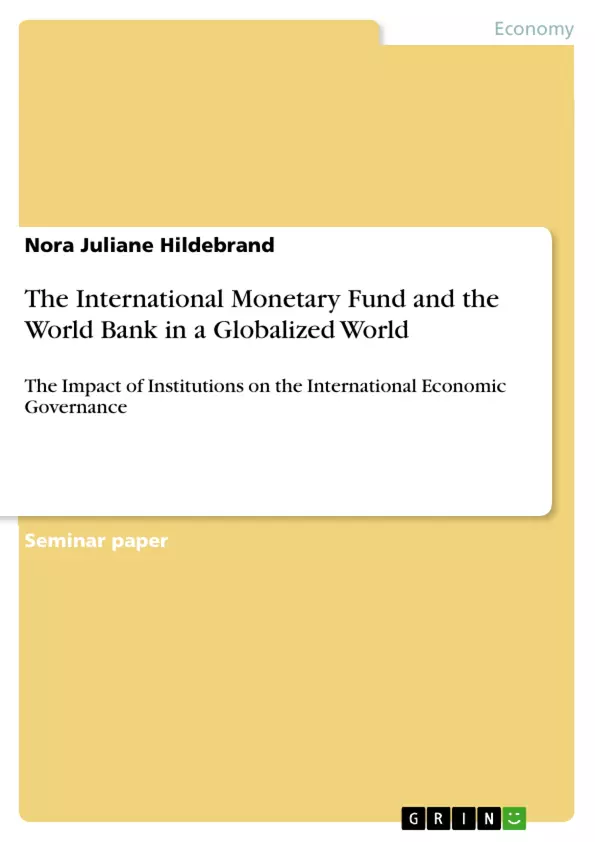This seminar paper mainly explains the areas of responsibility as well as the objectives of the International Monetary Fund (IMF) and the World Bank. Differences between the two international institutions will get clearer and a case study and criticism contribute to a better understanding.
There is no doubt that the process of globalization, defined as the gradual movement towards a more intertwined world, has enriched our personal life economically and culturally. We benefit from international cooperation, free trade, innovation, a broader knowledge, and facilitated communication and generally, we are offered more possibilities to shape our life as it may best please us. Nevertheless, global interdependence implicates fierce competition and therefore a stronger divide between rich and poor. Moreover, increasing environmental pollution and the violation of human rights are accepted, just to push forward economic success. In order to solve negative side effects caused by globalization, several associations have been established over the years. Among these, there is for example the Organisation for Economic Cooperation and Development (OECD), the World Trade Organisation (WTO), the United Nations (UN), the International Monetary Fund (IMF) and the World Bank.
This seminar paper focuses on the two latter institutions with the intention to illustrate their significant influence on prosperity and development. Even though the IMF and its "twin institution" are independent bodies that do not always collaborate in current projects, their responsibilities often overlap as they pursue the same goals: reducing poverty, supporting economic growth and global trade as well as stabilizing the international financial system. To maintain a clear overview about the organizations' differences, they will be described separately in the investigation. The roles of the International Monetary Fund and the World Bank are diverse, but always pursuing international stability. Superficially, the Bank and the IMF possess many similar characteristics, which makes it difficult to distinguish between them.
Inhaltsverzeichnis (Table of Contents)
- Introduction
- The International Monetary Fund
- General Information
- Facts and figures
- Foundation
- Governance Structure
- Distribution of quotas and votes
- Areas of responsibility
- Lending
- Economic surveillance
- Capacity development
- General Information
- World Bank
- General Information
- Facts and figures
- Foundation
- Governance Structure
- Distribution of Votes
- Funding source
- Areas of responsibility
- International Bank for Reconstruction and Development
- International Development Association
- General Information
- Case Study: Aid package for Ireland
- Criticism
Zielsetzung und Themenschwerpunkte (Objectives and Key Themes)
This seminar paper aims to examine the roles of the International Monetary Fund (IMF) and the World Bank in a globalized world. It investigates their impact on prosperity and development while highlighting their key areas of responsibility and influence.
- The role of the IMF and the World Bank in a globalized world
- The impact of these institutions on prosperity and development
- The areas of responsibility and influence of the IMF and the World Bank
- The effectiveness of IMF aid packages, illustrated through the case of Ireland
- The criticism surrounding the activities and influence of these institutions
Zusammenfassung der Kapitel (Chapter Summaries)
The introduction sets the stage by acknowledging the multifaceted nature of globalization and its impact on our lives. It emphasizes the need for institutions that address the negative side effects of globalization, including poverty, economic inequality, environmental pollution, and human rights violations. This paper focuses on the IMF and World Bank, which share the goal of promoting global economic stability and development.
Chapter 2 delves into the IMF, providing background information on its establishment, governance structure, and key functions. It highlights the institution's role in lending, economic surveillance, and capacity development. Chapter 3 follows a similar structure, examining the World Bank's organization, governance, and areas of responsibility. It distinguishes between the International Bank for Reconstruction and Development (IBRD) and the International Development Association (IDA), two key entities within the World Bank.
Chapter 4 offers a case study of an IMF aid package, focusing on the assistance provided to Ireland. This chapter analyzes the specific measures implemented and their intended impact. The paper concludes with a discussion of criticisms leveled against both the IMF and the World Bank, acknowledging the challenges and controversies surrounding their operations.
Schlüsselwörter (Keywords)
The key terms and concepts explored in this paper include globalization, International Monetary Fund (IMF), World Bank, economic development, poverty reduction, financial stability, international cooperation, aid packages, governance, and criticisms of international institutions. These themes are central to understanding the multifaceted role of the IMF and World Bank in the globalized world.
- Quote paper
- Nora Juliane Hildebrand (Author), 2015, The International Monetary Fund and the World Bank in a Globalized World, Munich, GRIN Verlag, https://www.grin.com/document/453988



